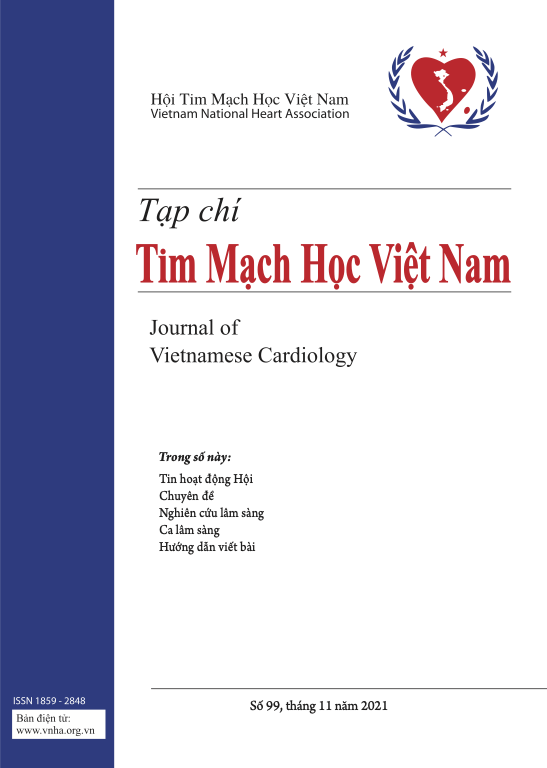Trầm cảm và một số yếu tố liên quan đến trầm cảm ở bệnh nhân tăng huyết áp tại thành phố Cần Thơ năm 2017-2018
Tóm tắt
Đặt vấn đề: Người bệnh tăng huyết áp có khả năng mắc kèm theo các rối loạn tâm thần trong đó có trầm cảm, dẫn tới làm tăng gánh nặng bệnh tật cho bệnh nhân, gia đình và xã hội.
Mục tiêu: Xác định tỷ lệ trầm cảm bằng thang đo PHQ9 và một số yếu tố liên quan đến trầm cảm ở người bệnh tăng huyết áp tại thành phố Cần Thơ năm 2017-2018.
Đối tượng và phương pháp nghiên cứu: Nghiên cứu cắt ngang trên 772 người bệnh tăng huyết áp tại thành phố Cần Thơ với độ tuổi trung bình là 64,6 tuổi (ĐLC: 12,29).
Kết quả nghiên cứu: 22,4% người bệnh có triệu chứng trầm cảm, trung bình là 2,66 điểm (SD: 3,38); trầm cảm mức độ nhẹ là 16,5%; trung bình là 4,3%; nặng và rất nặng là 1,6%. Người bệnh là nữ giới, hút thuốc lá, sử dụng rượu bia, tập luyện thể lực huyết áp tâm trương ≥ 90 mmHg, huyết áp tâm thu ≥ 140 mmHg có tổng điểm cao hơn với số điểm là 1,78; 2,37; 1,65; 0,88; 1,02; 3,12 điểm.
Người bệnh không thừa cân và tuân thủ điều trị có tổng điểm giảm lần lượt 0,09 điểm và 0,94 điểm. Trầm cảm gặp ở người lớn tuổi nhiều hơn với OR=0,95. Hoạt động thể lực đúng, không sử dụng rượu bia, BMI bình thường và tuân thủ điều trị thuốc mắc trầm cảm ít hơn với OR lần lượt là 0,61; 0,89 và 1,15.
Kết luận: Trầm cảm có thể làm nặng hơn tình trạng bệnh tăng huyết áp nói riêng và mãn tính nói chung.
Từ khóa: Tăng huyết áp, trầm cảm, rối loạn tâm thần.
Tài liệu tham khảo
1. Lý Thị Phương Hoa, Võ Tấn Sơn & Berbiglia, V., (2010), Tỷ lệ trầm cảm ở người bệnh tăng huyết áp điều trị ngoại trú tại bệnh viện Nguyễn Tri Phương, Tạp chí Y học Thành phố Hồ Chí Minh, 14(4).
![]()
2. Abdullah D. AlKhathami, et al. (2017), Depression and anxiety among hypertensive and diabetic primary health care patients, SaudiMedJ. 2017 Jun; 38(6): 621–628, Doi: [10.15537/smj.2017.6.17941].
![]()
3. Kroenke K, Spitzer RL, Williams JBW, (2001), The PHQ9: validity of a brief depression severity measure. J Gen Intern Med. 2001, 16:606–613.
![]()
4. Li Z, Li Y, Chen L, et al. (2015), Prevalence of depression in patients with hypertension: a systematic review and meta-analysis, Medicine, 94:e1317. 10.1097/MD.0000000000001317
![]()
5. Mandreker Bahall (2019), Prevalence and associations of depression among patients with cardiac diseases in a public health institute in Trinidad and Tobago, BMC Psychiatry, 19 (4), https://doi. org/10.1186/s12888-018-1977-3
![]()
6. Mohammad Shoaib Hamrah, Mohammad Hassan Hamrah, et al. (2018), Anxiety and Depression among Hypertensive Outpatients in Afghanistan: A Cross-Sectional Study in Andkhoy City, InternationalJournalofHypertension, Volume 2018, Article ID 8560835.
![]()
7. Prathibha M. T., Sara Varghese, et al. (2017), Prevalence of depression among hypertensive individuals in urban Trivandrum: a cross-sectional study, Int J Community Med Public Health, 2017 Jun;4(6):2156-2161, https://www.ijcmph.com/index.php/ijcmph/article/view/1369/1219
https://www.ijcmph.com/index.php/ijcmph/article/view/1369/1219">
![]()
8. Sandra N. Ofori1, Frances N. Adiukwu (2018), Screening for Depressive Symptoms among Patients Attending Specialist Medical Outpatient Clinics in a Tertiary Hospital in Southern Nigeria, Psychiatry Journal, Volume 2018, Article ID 7603580.
![]()
9. Samar Mahmood, et al. (2017), Prevalence and Predictors of Depression Amongst Hypertensive Individuals in Karachi, Pakistan, Cureeus, DOI: 10.7759/cureus.1397, file:///C:/Users/namnb/ Downloads/Prevalence_and_Predictors_of_Depression_Amongst_Hy.pdf.
![]()
10. Roger Muñoz-Navarro, et al. (2017), Utility of the PHQ-9 to identify majordepressive disorder in adult patients inSpanish primary care centres, BMC Psychiatry, 17(1).
![]()
11. Zhanzhan Li, Yanyan Li, Lizhang Chen, Peng Chen, and Yingyun Hu (2015), “Prevalence of Depression in Patients With Hypertension: A Systematic Review and Meta-Analysis”, Medicine (Baltimore), 2015 Aug; 94(31): e1317.
![]()
Tải xuống
Đã Xuất bản
Các phiên bản
- 05-03-2023 (2)
- 05-03-2023 (1)








